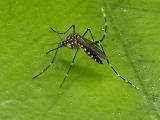The yellow fever situation in Angola is still highly concerning because of persistent transmission in Luanda, despite vaccination efforts, and health officials are also worried about further spread in the Democratic Republic of Congo (DRC) because of confirmed cases in one of the country's trade and transit hubs, the World Health Organization (WHO) said today in its weekly update.
Three more African countries reported suspected yellow fever cases, and efforts are under way to see if they signify local spread or are linked to outbreaks in Angola or Uganda. The Republic of Congo, Ethiopia, and the island nation Sao Tome and Principe are all probing suspected infections.
Ten provinces affected in Angola
In Angola, 2 more provinces—Cunene and Malange—are reporting local transmission, raising the total to 10. Also, teams have been sent to investigate the possibility of local transmission in 2 more provinces: Kwanza Norte and Cabinda.
Surveillance is being stepped up in Lunda Norte province, a location near the border with DRC that has a lot of travel related to activities such as diamond mining with legal and illegal workers, the WHO said. The area has already reported a cluster of cases, and DRC officials have also reported cases imported from Angola's Lunda Norte, which poses threats to other DRC provinces.
Vaccination has reached 8 million people in Angola, but yellow fever persists with activity concentrated in urban areas and main ports.
So far Angola has reported 2,983 suspected cases, 325 deaths, and 788 lab-confirmed cases.
The European Centre for Disease Control and Prevention (ECDC) said in its latest risk assessment on May 27 that cases in Angola have been declining since April, including in the hardest-hit provinces of Luanda and Huambo, but the disease continues to spread to new areas and is increasing in Benguela province.
DRC has 700 suspected cases
In a separate update today, the WHO said as of May 31, DRC authorities have reported 700 suspected cases so far, 63 of them fatal. Of 52 lab-confirmed cases in five provinces, 36 are from Kongo Central and 11 are from Kinshasa. Four cases aren't linked to Angola's outbreaks, including 2 sylvatic cases from Bas Uele and Tshuapa provinces and 2 locally transmitted cases from Kinshasa and Kongo Central provinces.
A vaccination campaign began on May 26, targeting nearly 2 million people in 11 health zones: 9 in Kongo Central and 2 in Kinshasa. The WHO said it has classified DRC's outbreak as a grade 2 emergency and has deployed a team to the two hardest-hit provinces to provide technical support and help local authorities.
In its DRC risk assessment, the WHO said though the region is a known yellow fever transmission area, outbreaks in highly populated areas are unusual and pose a threat of spread to other parts of the country. It warned that it expects more cases of local transmission to be reported because of the continuing flow of imported cases from Angola and vaccination levels that aren't at their goals yet.
Meanwhile, an unrelated outbreak in Uganda now has 68 suspected cases, an increase of 8 from the previous week, the WHO said.
Suspected cases in 3 more countries
The WHO said the Republic of Congo has reported a suspected case in Bouenza department, which borders Angola and DRC. The agency added that efforts are under way to determine the patient's vaccination status and if the case is local or imported.
Ethiopia has reported 22 suspected cases, 5 of them fatal, and investigators are probing any possible links to Uganda or Angola. The country experienced its last yellow fever outbreak in 2013.
In Sao Tome and Principe, two suspected yellow fever cases imported from Angola's Luanda province have been reported, and authorities are trying to determine if the patients had been effectively vaccinated.
Yellow fever in South America
Peru has reported 43 suspected yellow fever cases, 4 of them fatal, with 14 of the cases confirmed, the WHO said. Most of the cases are from an endemic area, and though the risk of spread to the Pacific coast isn't likely, the number of cases so far is more than double those reported in the previous 2 years. Peru's outbreak isn't linked to the event in Angola, the WHO said.
Brazil has had sporadic cases in unvaccinated people who were exposed in areas where yellow fever is endemic, the WHO said. One fatal case was reported in Sao Paulo state in March.
See also:
Jun 2 WHO yellow fever situation report
May 27 ECDC risk assessment
Jun 2 WHO update on yellow fever in DRC



















